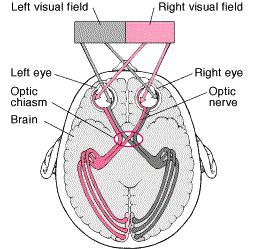Q: I have a Lt. Colonel blinded by shrapnel when he is ambushed while on patrol in Iraq. I have it that the projectile enters his temple and other shrapnel pocks his neck. Is this possible without visual damage to the eyes although he has scars on the temple? In other words, his eyes “look” fine, but he’s blind. Could a hit like that destroy the optic nerve without brain damage? I know that most blinding incidents occur from direct hits to the eye or from the pressure of explosives, so I want to be correct when explaining his injury.
A: First, a little anatomy. Here is a link to a diagram that will help you understand the explanation: http://www.medicalook.com/human_anatomy/organs/Optic_nerve.html
The optic nerves connect the optic cortex, which is the portion of the cerebral cortex involved with vision, with the retinas in a crossover pattern at what is called the optic chiasm. The left sided optic cortex supplies fibers through the brain to the left portion of the retina of each eye. This portion of the retina sees to the right. The right side optic cortex supplies fibers to the right portion of the retina of both eyes and sees to the left. Study the diagram in the link and this should be easy to see.

An injury on one side of the head that involves the optic nerve, say to the left eye, could cause blindness in the left eye only. The same would be true of the right. If the injury were deep enough that it reached the base of the brain and damaged the optic chaism and was severe enough to damage all the optic fibers then blindness would be bilateral because none of the optic fibers would be able to reach the retina. This would be a very severe head injury since these fibers lie deep into the skull at the base of the brain. He could survive it but it would require luck and fairly immediate cranial surgery.
The injury could also come to the back of the head and the optic cortex could be damaged. The optic cortex is the hind-most portion of each brain hemisphere. Injuries to these areas can result in what we call cortical blindness since the blindness comes from an injury and malfunction of the cortex of the brain. If the injury were to the right sided optical cortex he would be blind in his left visual field. We call this a left homonymous hemianopsia which is a big word meaning blindness in the left side of the visual field of both eyes. Here his visual field would be cut in half. The right half of the field would be normal and the left half dark as if a curtain had been pulled before his face. Of course if the left-sided cortex were damaged, he would be blind in his right visual field and would have a right homonymous hemianopsia. If the damage was to both of the optic cortices he would be completely blind.
So he could be blind in one eye with an injury to the optic nerve, both eyes if the injury involved the optic chiasm, a homonymous hemianopsia if one side of the cortex were damaged, and total cortical blindness if both optic cortices were damaged.
The chiasm could be damaged by a penetrating wound or from the concussion of the blast without penetration while damage to a single optic nerve would more likely occur with a penetrating wound. Complete or partial cortical blindness could follow either blunt or penetrating trauma to the optical cortices. But almost anything is possible.
